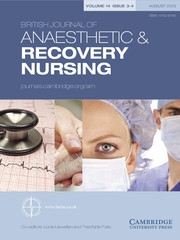Article contents
The Impact of Culture on Anaesthetic Practice
Published online by Cambridge University Press: 25 February 2009
Extract
IN debating the issue of whether or not nursing care should be perceived within a framework of cultural competence, this paper briefly describes the background of this approach to nursing, and as an exemplar, discusses how culture can impact on the practice of anaesthetics and peri–anaesthetic care. This is illustrated through drawing on my own transcultural experiences while employed for nearly five years as a non–physician anaesthetist in Saudi Arabia and may therefore be of interest to those practitioners involved in the delivery of anaesthetics and peri–anaesthetic care.
- Type
- Original Article
- Information
- Copyright
- Copyright © British Association of Anaesthetic and Recovery Nursing 2004
References
- 1
- Cited by


